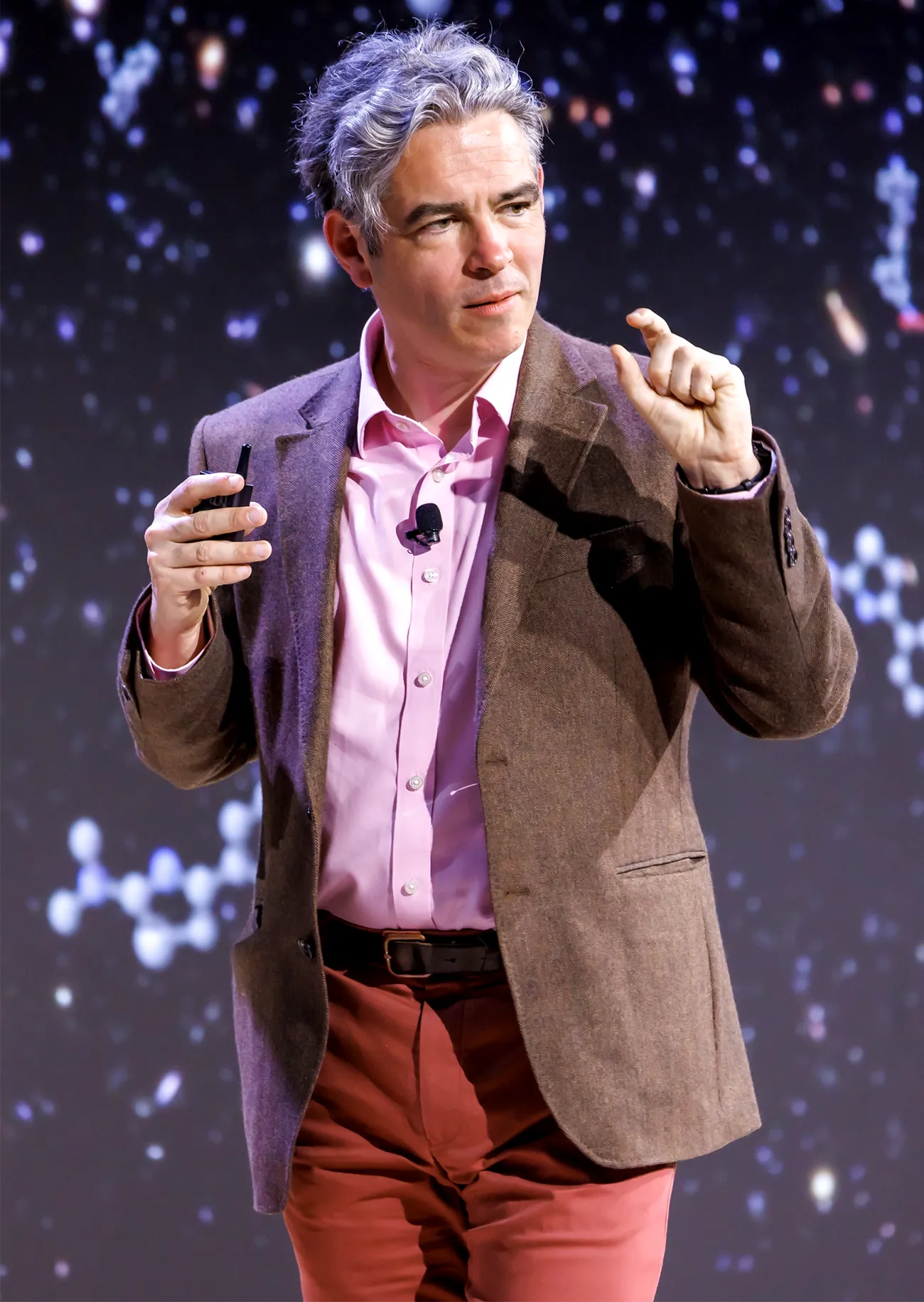A New Idea for How to Assemble Life

Assembly theory explains why, given seemingly infinite combinatorial possibilities, we only observe a certain subset of objects in our universe.
Samuel Velasco/Quanta Magazine
Introduction
Life on other worlds — if it exists — might be so alien as to be unrecognizable. There’s no guarantee that alien biology would use the same chemistries as on Earth, with familiar building blocks such as DNA and proteins. Scientists might even spot the signatures of such life forms without knowing they’re the work of biology.
This problem is far from hypothetical. In April, the European Space Agency’s Juice spacecraft blasted off from French Guiana on a course to Jupiter and its moons. One of those moons, Europa, has a deep, briny ocean beneath its frozen crust and is among the most promising places in the solar system to look for alien life. Next year, NASA’s Europa Clipper spacecraft will launch, also aiming for Europa. Both spacecraft have onboard instruments that will look for the fingerprints of complex organic molecules — a possible hint of life beneath the ice. And in 2027, NASA plans to launch a dronelike helicopter called Dragonfly to buzz over the surface of Saturn’s moon Titan, a hazy, carbon-rich world with liquid hydrocarbon lakes that might be just right for hosting life — but not as we know it.
These and other missions on the horizon will face the same obstacle that has plagued scientists since they first attempted to search for signs of Martian biology with the Viking landers in the 1970s: There is no definitive signature of life.
That might be about to change. In 2021, a team led by Lee Cronin of the University of Glasgow in Scotland and Sara Walker of Arizona State University proposed a very general way to identify molecules made by living systems — even those using unfamiliar chemistries. Their method, they said, simply assumes that alien life forms will produce molecules with a chemical complexity similar to that of life on Earth.
Called assembly theory, the idea underpinning the pair’s strategy has even grander aims. As laid out in a recent series of publications, it attempts to explain why apparently unlikely things, such as you and me, even exist at all. And it seeks that explanation not, in the usual manner of physics, in timeless physical laws, but in a process that imbues objects with histories and memories of what came before them. It even seeks to answer a question that has perplexed scientists and philosophers for millennia: What is life, anyway?
Not surprisingly, such an ambitious project has aroused skepticism. Its proponents have not yet made clear how it might be tested in the lab. And some scientists wonder whether assembly theory can even deliver on its more modest promises to distinguish life from nonlife, and to think about complexity in a new way.

Assembly theory evolved, in part, to capture Lee Cronin’s suspicion that “complex molecules can’t just emerge into existence, because the combinatorial space is too vast.”
Courtesy of Lee Cronin
But others feel that these are still early days for assembly theory, and there’s a real chance that it might bring a fresh perspective to the question of how complexity arises and evolves. “It’s fun to engage with,” said the evolutionary theorist David Krakauer, president of the Santa Fe Institute. Assembly theory, he said, offers a way to discover the contingent histories of objects — an issue ignored by most theories of complexity, which tend to focus on the way things are but not how they got to be that way. Paul Davies, a physicist at Arizona State agrees, calling it “a novel idea with the potential to transform the way we think about complexity.”
On the Order of Things
Assembly theory started when Cronin asked why, given the astronomical number of ways to combine different atoms, nature makes some molecules and not others. It’s one thing to say that an object is possible according to the laws of physics; it’s another to say there’s an actual pathway for making it from its component parts. “Assembly theory was developed to capture my intuition that complex molecules can’t just emerge into existence because the combinatorial space is too vast,” Cronin said.
Walker, meanwhile, had been wrestling with the question of life’s origin — an issue closely related to making complex molecules, because those in living organisms are far too complex to have been assembled by chance. Something, Walker mused, must have guided that process even before Darwinian selection took over.
Cronin and Walker joined forces after attending a NASA astrobiology workshop in 2012. “Sara and I were discussing information theory and life and minimal routes to build self-replicating machines,” Cronin recalled. “And it became very clear to me that we were both converging on the fact that there was a missing ‘driving force’ before biology.”
Now, the pair says, assembly theory provides a consistent and mathematically precise account of the apparent historical contingency of how things get made — why, for example, you can’t develop rockets until you first have multicellular life, then humans, and then civilization and science. There is a particular order in which objects can appear.
“We live in a recursively structured universe,” Walker said. “Most structure has to be built on memory of the past. The information is built up over time.”
That might seem intuitively obvious, but some questions about the order of things are harder to answer. Did dinosaurs have to precede birds? Did Mozart have to precede John Coltrane? Can we say which molecules necessarily preceded DNA and proteins?
Quantifying Complexity
Assembly theory makes the seemingly uncontroversial assumption that complex objects arise from combining many simpler objects. The theory says it’s possible to objectively measure an object’s complexity by considering how it got made. That’s done by calculating the minimum number of steps needed to make the object from its ingredients, which is quantified as the assembly index (AI).
In addition, for a complex object to be scientifically interesting, there has to be a lot of it. Very complex things can arise from random assembly processes — for example, you can make proteinlike molecules by linking any old amino acids into chains. In general, though, these random molecules won’t do anything of interest, such as behaving like an enzyme. And the chances of getting two identical molecules in this way are vanishingly small.
Functional enzymes, however, are made reliably again and again in biology, because they are assembled not at random but from genetic instructions that are inherited across generations. So while finding a single, highly complex molecule doesn’t tell you anything about how it was made, finding many identical complex molecules is improbable unless some orchestrated process — perhaps life — is at work.
Cronin and Walker figured that if a molecule is abundant enough to be detectable at all, its assembly index can indicate whether it was produced by an organized, lifelike process. The appeal of this approach is that it doesn’t assume anything about the detailed chemistry of the molecule itself, or that of the lifelike entity that made it. It’s chemically agnostic. And that makes it particularly valuable when we’re searching for life forms that might not conform to terrestrial biochemistry, said Jonathan Lunine, a planetary scientist at Cornell University and the principal investigator of a proposed mission to look for life on Saturn’s icy moon Enceladus.
“At least one relatively agnostic technique needs to be on board life-detection missions,” Lunine said.
And, he added, it’s possible to make the measurements demanded by assembly theory with techniques already used to study the chemistry on planetary surfaces. “Implementing measurements that allow the use of assembly theory in interpreting data is eminently doable,” he said.
A Measure of Life’s Work
What’s needed is a quick and easy experimental method for determining the AIs of particular molecules. Using a database of chemical structures, Cronin, Walker and their colleagues devised a way to calculate the minimum number of steps needed to make different molecular structures. Their results showed that, for relatively small molecules, the assembly index is roughly proportional to molecular weight. But for larger molecules (anything bigger than small peptides, say) this relationship breaks down.
In those cases the researchers found they could estimate AI using mass spectrometry — a technique already used by NASA’s Curiosity rover to identify chemical compounds on the surface of Mars, and by NASA’s Cassini spacecraft to study molecules erupting from Enceladus.
Mass spectrometry typically breaks large molecules into fragments. Cronin, Walker and colleagues found that during this process, large molecules with high AIs fracture into more complex mixtures of fragments than those with low AIs (such as simple, repetitive polymers). In this way the researchers could reliably determine an AI based on the complexity of the molecule’s mass spectrum.
When the researchers then tested the technique, they found that complex mixtures of molecules made by living systems — a culture of E. coli bacteria, natural products like taxol (a metabolite of the Pacific yew tree with anti-cancer properties), beer, and yeast cells — typically had significantly higher average AIs than minerals or simple organics.
The analysis is susceptible to false negatives — some products of living systems, such as Ardbeg single malt scotch, have AIs suggesting a nonliving origin. But perhaps more importantly, the experiment produced no false positives: Abiotic systems can’t muster sufficiently high AIs to mimic biology. So the researchers concluded that if a sample with a high molecular AI is measured on another world, it is likely to have been made by an entity we could call living.
Merrill Sherman/Quanta Magazine; source: https://doi.org/10.1038/s41467-021-23258-x
Mass spectrometry would only work in astrobiological searches that have access to physical samples — that is, lander missions, or some orbiters like Europa Clipper that can pick up and analyze molecules ejected from a world’s surface. But Cronin and colleagues have now shown that they can measure molecular AIs using two other techniques that offer consistent results. One of them, infrared spectroscopy, could be used by instruments such as those on the James Webb Space Telescope that remotely survey the chemical composition of faraway worlds.
That’s not to say that these molecular detection methods offer a clean measuring stick that ranges from rock to reptile. Hector Zenil, a computer scientist and biotechnologist at the University of Cambridge, pointed out that the substance with the single highest AI of all the samples the Glasgow group tested — a substance that by this measure might be considered the most “biological” — was not a bacterium.
It was beer.
Shedding the Shackles of Determinism
Assembly theory predicts that objects like us can’t arise in isolation — that some complex objects can only occur in conjunction with others. This makes intuitive sense; the universe could never produce just a single human. To make any humans at all, it had to make a whole bunch of us.
In accounting for specific, actual entities like humans in general (and you and me in particular), traditional physics is only of so much use. It provides the laws of nature, and assumes that specific outcomes are the result of specific initial conditions. In this view, we must have been somehow encoded in the first moments of the universe. But it surely requires extremely fine-tuned initial conditions to make Homo sapiens (let alone you) inevitable.
Assembly theory, its advocates say, escapes from that kind of overdetermined picture. Here, the initial conditions don’t matter much. Rather, the information needed to make specific objects like us wasn’t there at the outset but accumulates in the unfolding process of cosmic evolution — it frees us from having to place all that responsibility on an impossibly fine-tuned Big Bang. The information “is in the path,” Walker said, “not the initial conditions.”
Cronin and Walker aren’t the only scientists attempting to explain how the keys to observed reality might not lie in universal laws but in the ways that some objects are assembled or transformed into others. The theoretical physicist Chiara Marletto of the University of Oxford is developing a similar idea with the physicist David Deutsch. Their approach, which they call constructor theory and which Marletto considers “close in spirit” to assembly theory, considers which types of transformations are and are not possible.
“Constructor theory talks about the universe of tasks able to make certain transformations,” Cronin said. “It can be thought of as bounding what can happen within the laws of physics.” Assembly theory, he says, adds time and history into that equation.
To explain why some objects get made but others don’t, assembly theory identifies a nested hierarchy of four distinct “universes.”
In the Assembly Universe, all permutations of the basic building blocks are allowed. In the Assembly Possible, the laws of physics constrain these combinations, so only some objects are feasible. The Assembly Contingent then prunes the vast array of physically allowed objects by picking out those that can actually be assembled along possible paths. The fourth universe is the Assembly Observed, which includes just those assembly processes that have generated the specific objects we actually see.
Merrill Sherman/Quanta Magazine; source: https://doi.org/10.48550/arXiv.2206.02279
Assembly theory explores the structure of all these universes, using ideas taken from the mathematical study of graphs, or networks of interlinked nodes. It is “an objects-first theory,” Walker said, where “the things [in the theory] are the objects that are actually made, not their components.”
To understand how assembly processes operate within these notional universes, consider the problem of Darwinian evolution. Conventionally, evolution is something that “just happened” once replicating molecules arose by chance — a view that risks being a tautology, because it seems to say that evolution started once evolvable molecules existed. Instead, advocates of both assembly and constructor theory are seeking “a quantitative understanding of evolution rooted in physics,” Marletto said.
According to assembly theory, before Darwinian evolution can proceed, something has to select for multiple copies of high-AI objects from the Assembly Possible. Chemistry alone, Cronin said, might be capable of that — by narrowing down relatively complex molecules to a small subset. Ordinary chemical reactions already “select” certain products out of all the possible permutations because they have faster reaction rates.
The specific conditions in the prebiotic environment, such as temperature or catalytic mineral surfaces, could thus have begun winnowing the pool of life’s molecular precursors from among those in the Assembly Possible. According to assembly theory, these prebiotic preferences will be “remembered” in today’s biological molecules: They encode their own history. Once Darwinian selection took over, it favored those objects that were better able to replicate themselves. In the process, this encoding of history became stronger still. That’s precisely why scientists can use the molecular structures of proteins and DNA to make deductions about the evolutionary relationships of organisms.
Thus, assembly theory “provides a framework to unify descriptions of selection across physics and biology,” Cronin, Walker and colleagues wrote. “The ‘more assembled’ an object is, the more selection is required for it to come into existence.”
“We’re trying to make a theory that explains how life arises from chemistry,” Cronin said, “and doing it in a rigorous, empirically verifiable way.”
One Measure to Rule Them All?
Krakauer feels that both assembly theory and constructor theory offer stimulating new ways to think about how complex objects come into being. “These theories are more like telescopes than chemistry labs,” he said. “They allow us to see things, not make things. That is not at all a bad thing and could be very powerful.”
But he cautions that “like all of science, the proof will be in the pudding.”
Zenil, meanwhile, believes that, given an already considerable roster of complexity metrics such as Kolmogorov complexity, assembly theory is merely reinventing the wheel. Marletto disagrees. “There are several measures of complexity around, each capturing a different notion of complexity,” she said. But most of those measures, she said, are not related to real-world processes. For example, Kolmogorov complexity assumes a kind of device that can put together anything the laws of physics permit. It’s a measure appropriate to the Assembly Possible, Marletto said, but not necessarily to the Assembly Observed. In contrast, assembly theory is “a promising approach because it focuses on operationally defined, physical properties,” she said, “rather than abstract notions of complexity.”
What’s missing from such previous complexity measures, Cronin said, is any sense of the history of the complex object — the measures don’t distinguish between an enzyme and a random polypeptide.
Cronin and Walker hope that assembly theory will ultimately address very broad questions in physics, such as the nature of time and the origin of the second law of thermodynamics. But those goals are still distant. “The assembly-theory program is still in its infancy,” Marletto said. She hopes to see the theory put through its paces in the laboratory. But it might happen out in the wild too — in the hunt for lifelike processes happening on alien worlds.



